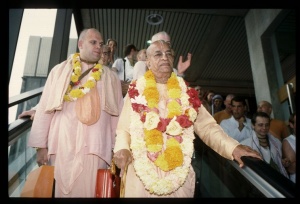SB 1.4.25

A.C. Bhaktivedanta Swami Prabhupada
TEXT 25
- strī-śūdra-dvijabandhūnāṁ
- trayī na śruti-gocarā
- karma-śreyasi mūḍhānāṁ
- śreya evaṁ bhaved iha
- iti bhāratam ākhyānaṁ
- kṛpayā muninā kṛtam
SYNONYMS
strī — the woman class; śūdra — the laboring class; dvija-bandhūnām — of the friends of the twice-born; trayī — the three sacrificial Vedas; na śruti-gocarā — not allowed to be heard; karma-śreyasi — in the successful execution of ritual duties; mūḍhānāṁ — of the less intelligent; śreyaḥ — supreme benefit; evam — thus; bhavet — achieved; iha — by this; iti — thus thinking; bhāratam — the great Mahābhārata; ākhyānam — historical facts; kṛpayā — out of great mercy; muninā — by the muni; kṛtam — is completed.
TRANSLATION
Out of compassion, the great sage thought it wise that this would enable men to achieve the ultimate goal of life. Thus he compiled the great historical narration called the Mahābhārata for women, laborers and friends of the twice-born.
PURPORT
The friends of the twice-born families are those who are born in the families of brāhmaṇas, kṣatriyas and vaiśyas, or the spiritually cultured families, but who themselves are not equal to their forefathers. Such descendants are not recognized as such, for want of purificatory achievements. The purificatory activities begin even before the birth of a child, and the seed-giving reformatory process is called Garbhādhāna-saṁskāra. One who has not undergone such Garbhādhāna-saṁskāra, or spiritual family planning, is not accepted as being of an actual twice-born family. The Garbhādhāna-saṁskāra is followed by other purificatory processes, out of which the sacred thread ceremony is one. This is performed at the time of spiritual initiation. After this particular saṁskāra, one is rightly called twice-born. One birth is calculated during the seed-giving saṁskāra, and the second birth is calculated at the time of spiritual initiation. One who has been able to undergo such important saṁskāras can be called a bona fide twice-born.
If the father and the mother do not undertake the process of spiritual family planning and simply beget children out of passion only, their children are called dvija-bandhus. These dvija-bandhus are certainly not as intelligent as the children of the regular twice-born families. The dvija-bandhus are classified with the śūdras and the woman class, who are by nature less intelligent. The śūdras and the woman class do not have to undergo any saṁskāra save and except the ceremony of marriage.
The less intelligent classes of men, namely women, śūdras and unqualified sons of the higher castes, are devoid of necessary qualifications to understand the purpose of the transcendental Vedas. For them the Mahābhārata was prepared. The purpose of the Mahābhārata is to administer the purpose of the Vedas, and therefore within this Mahābhārata the summary Veda of Bhagavad-gītā is placed. The less intelligent are more interested in stories than in philosophy, and therefore the philosophy of the Vedas in the form of the Bhagavad-gītā is spoken by the Lord Śrī Kṛṣṇa. Vyāsadeva and Lord Kṛṣṇa are both on the transcendental plane, and therefore they collaborated in doing good to the fallen souls of this age. The Bhagavad-gītā is the essence of all Vedic knowledge. It is the first book of spiritual values, as the Upaniṣads are. The Vedānta philosophy is the subject matter for study by the spiritual graduates. Only the post-graduate spiritual student can enter into the spiritual or devotional service of the Lord. It is a great science, and the great professor is the Lord Himself in the form of Lord Śrī Caitanya Mahāprabhu. And persons who are empowered by Him can initiate others in the transcendental loving service of the Lord.